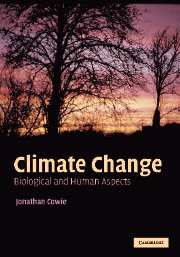Book contents
- Frontmatter
- Contents
- Introduction
- Acknowledgements
- 1 An introduction to climate change
- 2 Principal indicators of past climates
- 3 Past climate change
- 4 The Oligocene to the Quaternary: climate and biology
- 5 Present climate and biological change
- 6 Current warming and likely future impacts
- 7 The human ecology of climate change
- 8 Sustainability and policy
- Appendix 1 Glossary and abbreviations
- Appendix 2 Bio-geological chronology
- Appendix 3 Calculations of energy demand/supply and orders of magnitude
- Appendix 4 The IPCC 2007 report
- Index
- References
2 - Principal indicators of past climates
Published online by Cambridge University Press: 17 December 2010
- Frontmatter
- Contents
- Introduction
- Acknowledgements
- 1 An introduction to climate change
- 2 Principal indicators of past climates
- 3 Past climate change
- 4 The Oligocene to the Quaternary: climate and biology
- 5 Present climate and biological change
- 6 Current warming and likely future impacts
- 7 The human ecology of climate change
- 8 Sustainability and policy
- Appendix 1 Glossary and abbreviations
- Appendix 2 Bio-geological chronology
- Appendix 3 Calculations of energy demand/supply and orders of magnitude
- Appendix 4 The IPCC 2007 report
- Index
- References
Summary
If palaeoclimatologists had their wildest dreams come true then we would undoubtedly see them travelling back in time to make meteorological recordings before humans existed, let alone thermometers. Were that life be that obliging. Instead, preserved indications of past climate have to be identified, calibrated and then used to infer usually just one aspect of the climate, and frequently that one aspect at just one locality. Such a preserved indication provides us with a single proxy measurement.
Many measurements are needed from many proxies in order to build up a climatic picture of the past. The products of proxy analyses are often termed palaeoclimatic data. Palaeoclimatic data commonly come with considerable uncertainty in one or more of the following regards: the inferred temperature, the inferred time, and the space to which it applies. It is important to emphasise this and to recognise that most proxy data rarely ever give a direct measure of a single meteorological parameter. For example, tree-ring thickness is affected by numerous factors, not just climate. These include the aspect in which the tree is found, be it in a valley or on a hillside, and whether it is south or north facing; soils, which affect nutrients; and local geology, which affects water availability.
- Type
- Chapter
- Information
- Climate ChangeBiological and Human Aspects, pp. 37 - 66Publisher: Cambridge University PressPrint publication year: 2007



